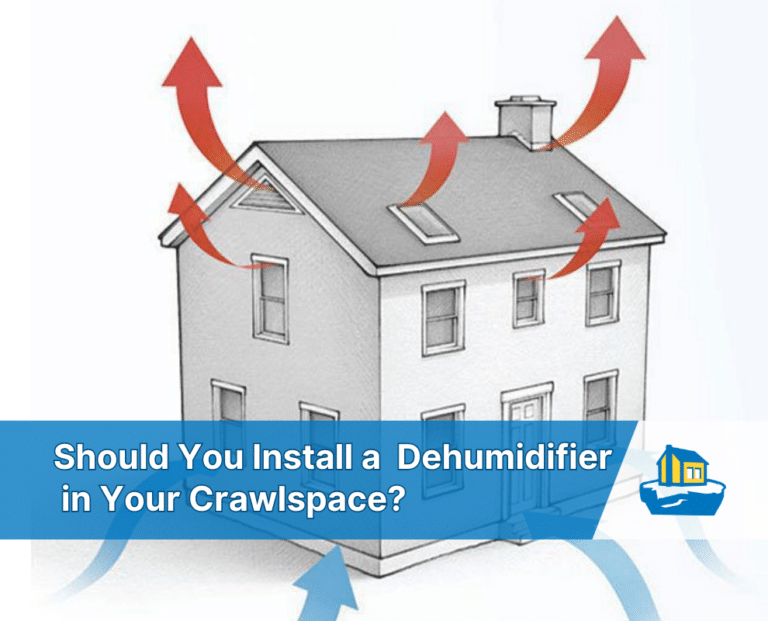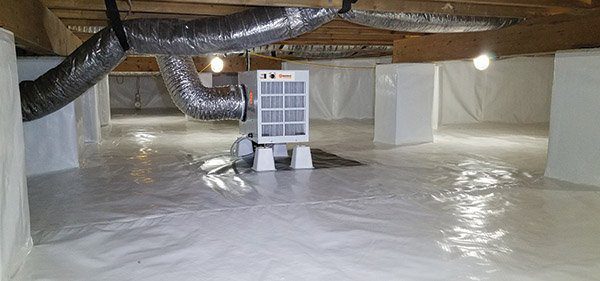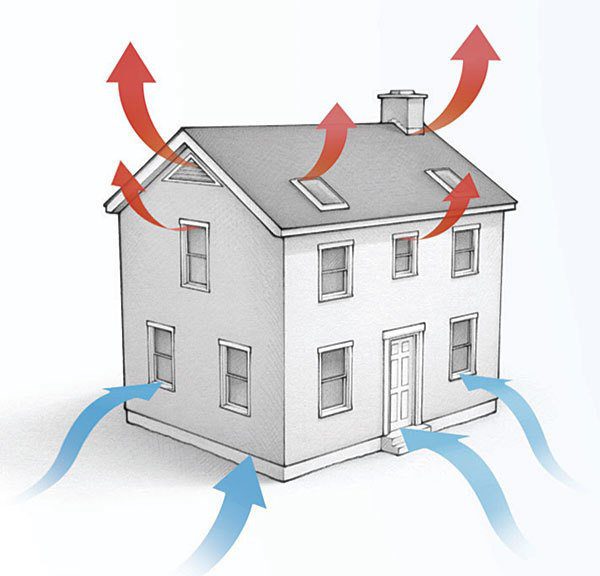4.8 1700+ Google Reviews

There’s a good chance you’ve never been in your crawlspace. I don't blame you though. No one likes tight spaces, musty odors, and dust spores. Sometimes, your house has symptoms like musty smells, soft floors, or sticking doors and windows. At this point many homeowners wonder if they should put a dehumidifier in their crawlspace.
When we do an inspection, we inspect the Crawlspace last and everything can be going fine right up until then. The condition of the Crawlspace can make or break the deal. A moldy crawl space from excess moisture can cost several thousands of dollars to address. And if it’s been an undetected chronic issue, there can be water damage such as rotted floor joists, or termites causing other structural damage. That can easily the double the cost of repairs. It doesn’t need to be this way though. A little effort can a long way to preventing costly repairs.
In addition to structural crawl space issues, mold growth from wet crawl spaces can cause poor air quality inside your entire home. This is due to the stack effect.
If your crawlspace has not been encapsulated, you should not install a dehumidifier...yet. It will constantly run and won't remove moisture.
Many homeowners who try to address crawl space moisture on their own install a dehumidifier. The problem is they aren't usually addressing the root cause first. To make matters worse, they buy a regular dehumidifier which usually does not process enough pints of moisture to deal with a very high humidity level. Simply installing a dehumidifier also does not address any growth of mold , foundation water seepage, or standing water.
If the crawlspace is not sealed, then outdoor and ground level air will continue to enter the crawlspace. At that point, even the best dehumidifier will not be able to keep up.
The ideal solution for a crawl space with moisture problems is encapsulation. A good encapsulation company provides a holistic approach to the common problems associated with a damp crawlspace. Crawlspace encapsulation involves sealing, and insulating the crawl space from the ground and outdoor air. In addition, they will either install a large capacity crawl space dehumidifier, or condition the space with the hvac system. This complete system gets the crawlspace to preferred humidity levels. Of course, if there is any wood rot, or presence of mold, this will need to be addressed before the encapsulation system can be installed. It can be a very expensive process, but it is one of the best options to deal with a chronically damp crawl space.
The good news is that high quality, professionally installed encapsulation system can reduce radon in your home, and cut down on energy costs. It makes your crawl space very low maintenance and is a great option if you can afford it.

You want to try to keep it that way! Here are three tips!
The first step is to keep your crawl space foundation vents closed all year long. Yes I said keep them closed all year long. Close your crawl space foundation vents in the summer. Close your crawl space foundation vents in the winter. Keep your crawl space foundation vents closed in the spring and fall. ALWAYS CLOSE YOUR CRAWL SPACE FOUNDATION VENTS. Yes, I know your dad doesn’t agree. It's just not true that your crawl space needs air circulation form outside air. I’m going to try to break this down Barney style. There are three important things to understand; temperature equilibrium, dew point, and humidity.
Temperature equilibrium is when two spaces of air (or any two objects) transfer energy until they’re the same temperature. The hotter space will transfer its energy to the cooler space.
Humidity – or rather relative humidity level is the amount of water in air, in the form of vapor, compared to how much water it can hold. Hot air can hold more moisture than cold air.
Dew point – this is the temperature air must be cooled to achieve 100 percent relative humidity. Remember, cool air holds less moisture than hot air, so given the same amount of water, as air gets colder, the relative humidity gets higher. This why relative humidity is highest early in the morning (coldest part of the day) and why you have dew in the morning.
Crawlspaces are always cooler than the outside temperature in spring and summer because they’re dark and shaded. There also may be an air handler or ducts that keep it colder.
When you open your crawlspace vents, hot humid air will be pushed into the crawlspace as the two spaces work towards temperature equilibrium. As the hot humid air is cooled in the crawlspace, the relative humidity is increasing, potentially reaching the dew point. Once the crawlspace reaches dew point, you will have condensation forming on all the colder surfaces such as pipes and ducts, but even wood and insulation.
A crawlspace with high moisture levels encourages mold growth, rot and decay.
The vapor barrier is the plastic that is (or should be) on the ground the crawlspace. It blocks water vapor, which is water that evaporated in the soil is making its back into the atmosphere, from going into your crawlspace. Remember, if you’re adding water vapor to your crawlspace, you’re increasing the relative humidity and runing the risk of allowing your crawlspace to reach its dew point.
The vapor barrier is never as good as it should be. It should be free of holes and sealed along all the joints and edges. Take an afternoon to improve your vapor barrier. It’s not fun, but neither is a 20k crawl space repair bill.
It takes a while for moisture to start rotting your joists and damaging other components. Sometimes, you won’t be able to prevent needing to fully encapsulate your crawl space, but you can prevent thousands in structural repairs. Check your crawlspace weekly for termites, moisture, mold, and leaks. If you see any of the above, you can quickly get it addressed before the problem festers and makes a mess of your crawlspace.
Perhaps once or twice a year get a professional in there such as termite inspector, or home inspector.
Stack effect is essentially hot/warm air rising up inside a building such as your home, and pulling in air from below it such as from your crawlspace.
Hot air rises, pulling air from lower places. Got it? When you are pulling in crawl space air you are bringing in mold spores, dust mites, and even its high levels of humidity into the living space.
When your hvac system (heat and air conditioners ) is installed in your home's crawl space, that makes matters even worse. Any leaks in the duct work are going to contaminate the supply air with the crawl space air.
If you install a dehumidifier in your crawlspace without encapsulating it, the stack effect is constantly pulling in more humid air into your crawlspace. Your dehumidifier will never be able to keep up.
